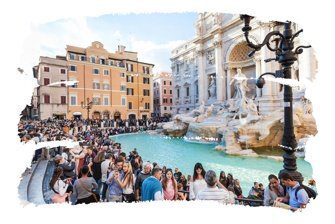How to visit Vesuvius?
The prospect of visiting a volcano can seem daunting, especially knowing that it is still active and can erupt at any moment, but there is no reason to worry, as all seismic and volcanic activities are monitored daily. If the visit cannot be carried out, there are issues of notices for residents and visitors. How to visit Vesuvius? Let’s learn everything now! Here at Your Travel to Italy with Ana Patricia you make the trip of your dreams!!! ALSO: see our “Accommodation in Italy – Tips for your holidays!”
Watch this video about Vesuvius with fantastic images made using a Drone
(Source: Aircraft Drones High Definition Video)
Introduction
Vesuvius is known mainly for having destroyed Pompeii and Herculaneum on August 24th, 79 A.D. and, until today, it still generates a certain fear for people. Contrary to what many people think, the volcano is active and can erupt at any time. It is still considered a dangerous volcano and is the most monitored in the world, due to the enormous danger of a new eruption occur and destroy the cities at the foot of the mountain. Shall we now get to know how to visit Vesuvius?
1) How to visit Vesuvius? FIRSTLY, INQUIRE ABOUT THE MONITORING!
Those responsible for monitoring Vesuvius are the staff of the Vesuvian Observatory. The ashes that the volcano expels from time to time have already caused the closure of several airports in Europe. They say that, unfortunately, the nearby cities do not have a functional evacuation plan (even with so much control over the activities of the volcano!) and in the event of an eruption, approximately 5 million people would suffer the consequences. In time: the temperature of the toxic ash in the volcano can reach 300 ° C and the rocks, debris and lava can be thrown hundreds of meters high, with no exact place to ‘land’.
But we have good news for you: it is possible to visit the volcano! Because of its intense monitoring, the volcano is open to the public and poses no danger, but in the event of any abnormal activity or bad weather, alerts are issued and access to the mountain is prohibited!
Attention
- It is worth noting that the climb is not that easy, but the view from the top is impressive! Is it worth it? Yes! Mainly because of the history of the mountain. But: how to get there? There are, of course, agencies that organize the guided tours.
Would you like a Tour of Naples: Pompeii and Vesuvius Full-Day Tour?
Click here with no commitment!
2) How to visit Vesuvius? KNOW BEFORE HOW TO GET THERE!
To get to the foot of Vesuvius (that is, at the entrance to the Vesuvius National Park), the best option is to get off at Ercolano Scavi Station. Leaving the Station go to the roundabout and turn left, on the other side of the street, at the end of the climb, there is a bus stop. To go to the base of the hill, take the bus ANM 5 (the ticket is integrated with the train!). Get off at Ercolano Via Vesuvius.
Attention to bus timetables
It really takes time! The interval between them is, more or less, 01h20min! (The first one leaves at 07h40min). Arriving in Vesuvius, legs for those who want you: just on foot!
3) How to visit Vesuvius? USEFUL INFORMATION!
On the way, there are some shops and at the entrance to the park, there is a bar and a restaurant where there are bathrooms. The height of the mountain is 1,281 m and reaching the top, seeing the almost constant smoke inside it (that has temperatures varying between 80 and 300 ° C), just proves that the volcano is only asleep and that it can awaken anytime.
To access the park, you pay 10 Euros and the visit time to the volcano is approximately 90 minutes. The Park is open every day, including Saturdays, Sundays and holidays. For more information, visit the Guide Vesuvio website. Observing this ‘sleepy monster’ in all its tranquility, it is almost impossible to imagine the strength that this giant of nature has under it. Ah, finally, take the opportunity to taste the Lacryma Christi, which is a type of wine that can be white, red or liqueur and is produced with grapes grown in the region.
Some Curiosities and Stories about the Vesuvius Volcano
How to visit Vesuvius? To visit the volcano it is important to know a little more about it, and if you like to know everything about the place you are going to visit, then do not miss some curiosities and a little about the history of the imposing Vesuvius Volcano.
Ancient Names of Vesuvius
Originally, the ancient peoples, unaware of the real presence of a volcano, gave Mount Vesuvius several names, among them: Besùbio, Bèsuvio, Bèsbio, Bèbio, Bèmbio, Bisvio, Vèsulo, Vèsuro, Vèsulo, Vèsvio, Vesùbio, Vèsebio, Mèulo , Esbio; note that everyone had the root “ves” which means fire burning earth. The Latins called him Iuppiter Vesuvius or Iuppiter Sommanus and associated him with Zeus. Another idea from mythology associated the volcano with the god Bacchus, the god of wine, because of the strong presence of the vineyards in the region.
Legend of God’s Wrath
After the terrible eruption that buried Pompeii and Herculaneum, the idea arose, during the early stages of Christianity, that every eruption in Vesuvius corresponded to God’s divine wrath! It was clearly a punishment against the Vesuvian people, who were pagans and, from that moment, in Christian iconography, Vesuvius was identified as the mouth of hell, the house of the devil and a symbol of evil.
Legend Vesuvius-Hell
From this legend and Vesuvius-Hell relationship many others were born, including the legend of the origin of Pulcinella, the carnival mask and the theatrical emblem of Naples. According to the 1700 story, Pulcinella was born from the shell of a magic egg, which appeared on the summit of Vesuvius at the behest of Pluto, the god of the dead, at the request of two Neapolitan sorcerers. They prepared the population saying that they would receive ‘a savior’, an ally of people who would remedy situations of injustice and oppression that weighed so heavily on the city.
One of the medieval legends says that the people who implored the arrival of an imminent eruption of Vesuvius in order to ask for help from Virgilio Mago, the Latin poet known for his magic, considered the first protector of Naples. It is said that Virgílio placed, near the volcano, an immense bronze statue that represented himself and had a dart in its mouth so that, in the event of an eruption, the dart would be thrown towards the volcano and would frighten it, stopping it from eroding! It is evident that the ‘magic’ against the force of nature could not do anything and, soon afterwards, several other eruptions followed, with less serious consequences, however.
Patron Saint
Naples needed another patron saint, an “effective” patron! It was here that the protection of St Januarius appeared, invoked several times in AD 472 and AD 512. It is said that during the terrible eruption of December 16th, 1631, Naples woke up feeling a strong earthquake followed by a terrible eruption that destroyed many cities in Vesuvius; With the gravity of what happened, the bust of St Januarius was taken in a procession that, facing the great volcano, had the power to ‘calm it down’. They say that the patron saint appeared among the clouds at the time of the eruption and ‘held’ the lava, avoiding a much greater tragedy!
Pietro Damiani’s Story
A very famous story in the region is that a man from the Church, Pietro Damiani, was reciting psalms when he saw black men bringing hay. The priest asked who they were and they said they were the demon, who were there to ‘feed’ the fire with hay to kill Duke John III burned alive. The priest then, who knew Duke Giovanni, reported everything to the nobleman, who reassured him that nothing would happen. Days later, Duke Giovanni was burned to death and, coincidence or not, red flames appeared at the top of Vesuvius. The population always says that, on that day, the demons were satisfied, because they had received the condemned soul, and celebrated by causing the volcano to erupt.
The Miracles of the Vesuvius Volcano
However, the volcano is also known for its ‘miracles’: in the 19th century, a man named Mauro was born with only a black face due to a pathology. He went to Vesuvius to ask for a grace, to be transformed into a “normal” man. With faith in his prayers, the volcano “granted” his request: he received a visit from an angel who took him into the volcano’s crater and blew ash into his face: Mauro, coming out of there, had white skin on his face! From that moment on, two craters of Vesuvius were named Angelo and Mauro. The volcano is surrounded by very interesting stories! It would be impossible to reproduce them all here!
Watch this video and learn: For which monuments in Italy should I buy the ticket in advance?
Subscribe to our channel and receive more videos with information and tips about Italy. Don’t forget to leave that Like;)
Conclusion
How to visit Vesuvius? Of unique beauty, Mount Vesuvius allows us to see a sleeping, impressive and mesmerizing force! Have you been there? What did you think of the tour? Leave your comment below! And if you feel insecure, have no time, and need help to organize your trip, don’t hesitate to contact me! I will love to help you make your dream trip to Italy come true. And how can I do that? Keep reading this post until the end and you will understand how we make your life and your trip much easier.
Did my post help you? If so, be sure to post your comment below, but if you still have questions just send me a message I will answer you as soon as possible!
An Extra Help for your Trip
The best content from Your Travel to Italy!
Learn more about our tours in Italy right now!
- What to visit in Italy in 10 days?
- The ten must-see places in Tuscany?
- The best tips to save on your trip to Italy?
- What are the 10 most visited cities in southern Italy?
- Airports in Italy? How to get to your hotel? (Venice, Milan, Rome, Florence)
- What to do in 1/2/3/4 days in the main Italian cities?
- The best tips on food in Italy (wines, typical food, enogastronomy tours)
- How to get from Fiumicino Airport to Rome downtown?
- Your Travel to Italy: 10 tips for traveling through Italy!
Best regards from Italy




 Save money!
Save money!